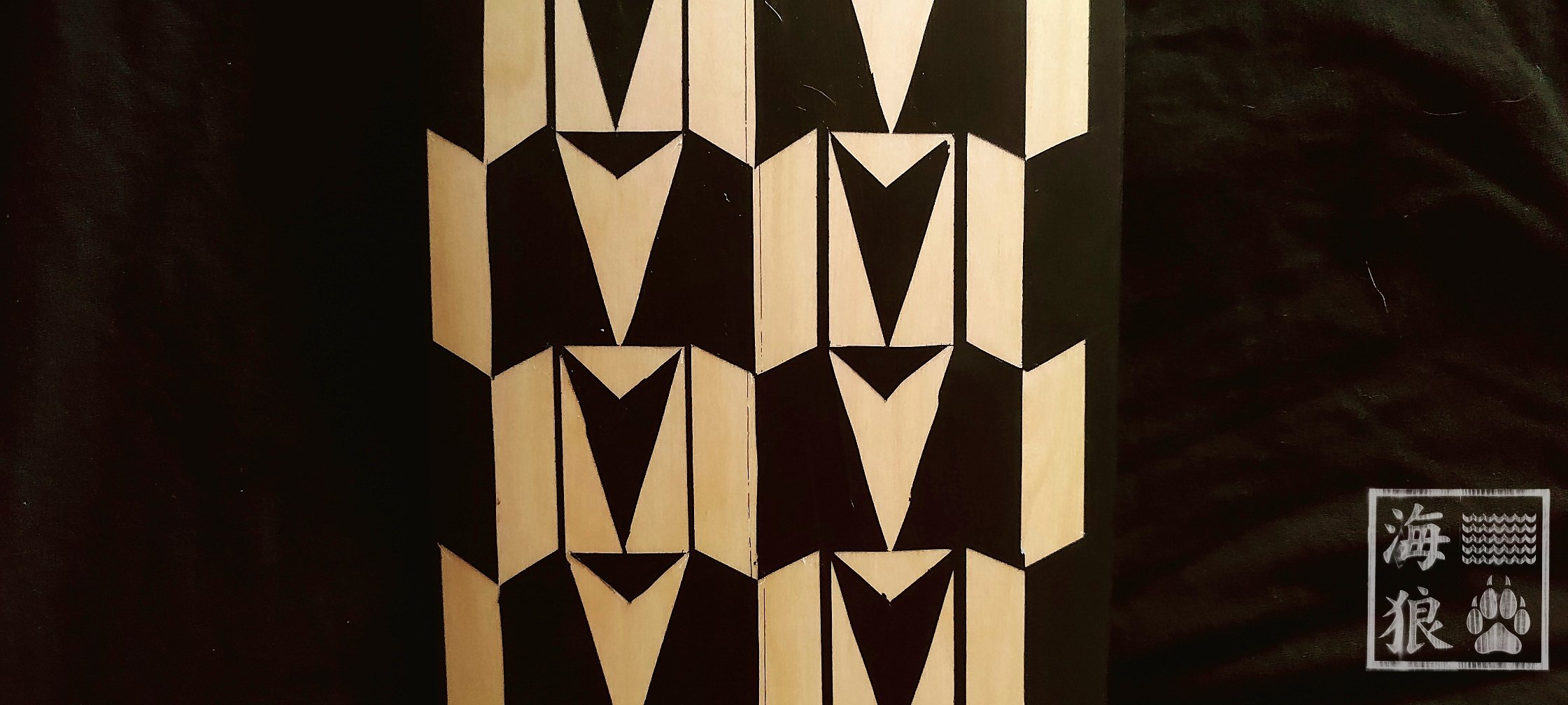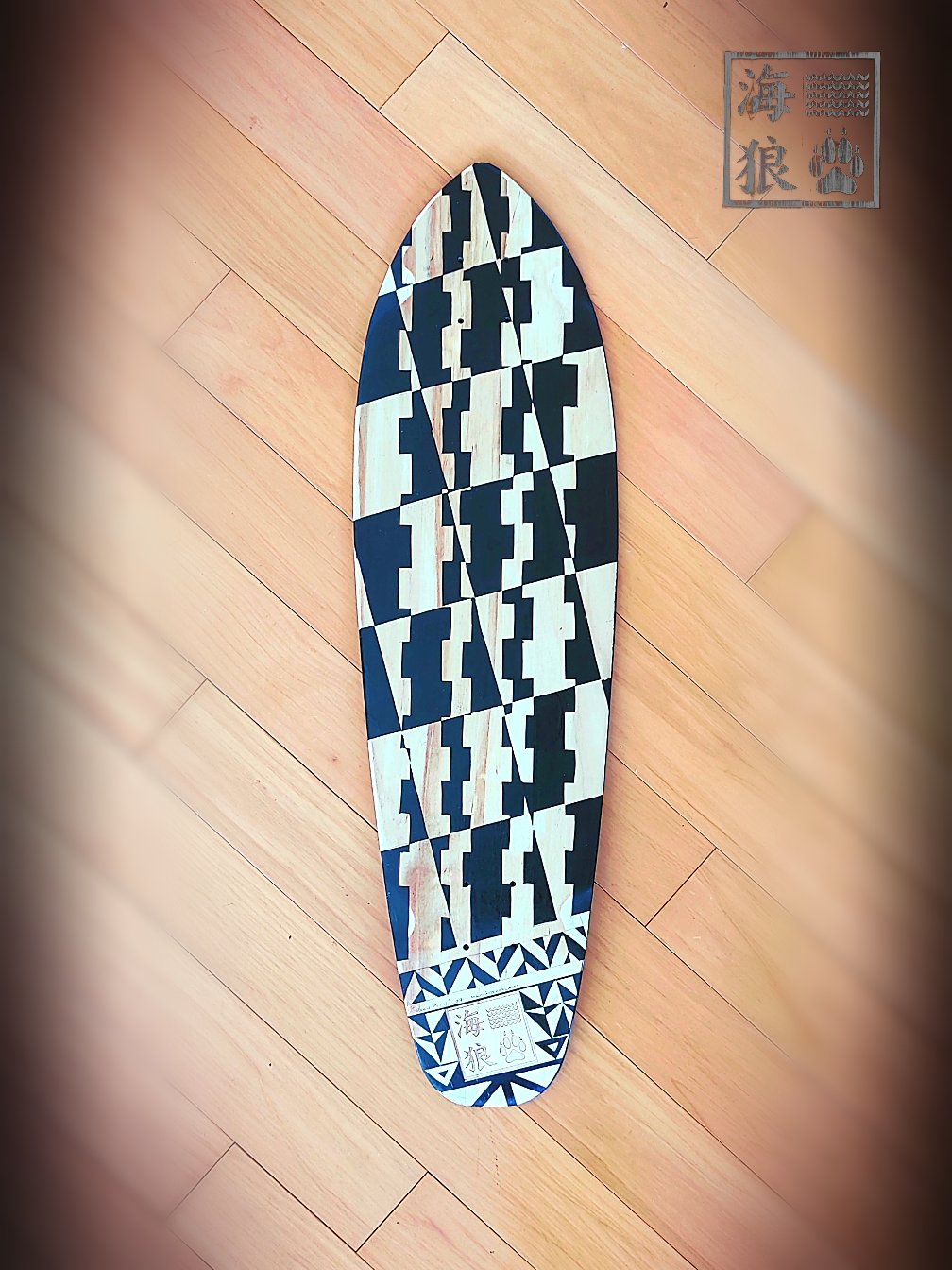 Image 1 of 6
Image 1 of 6

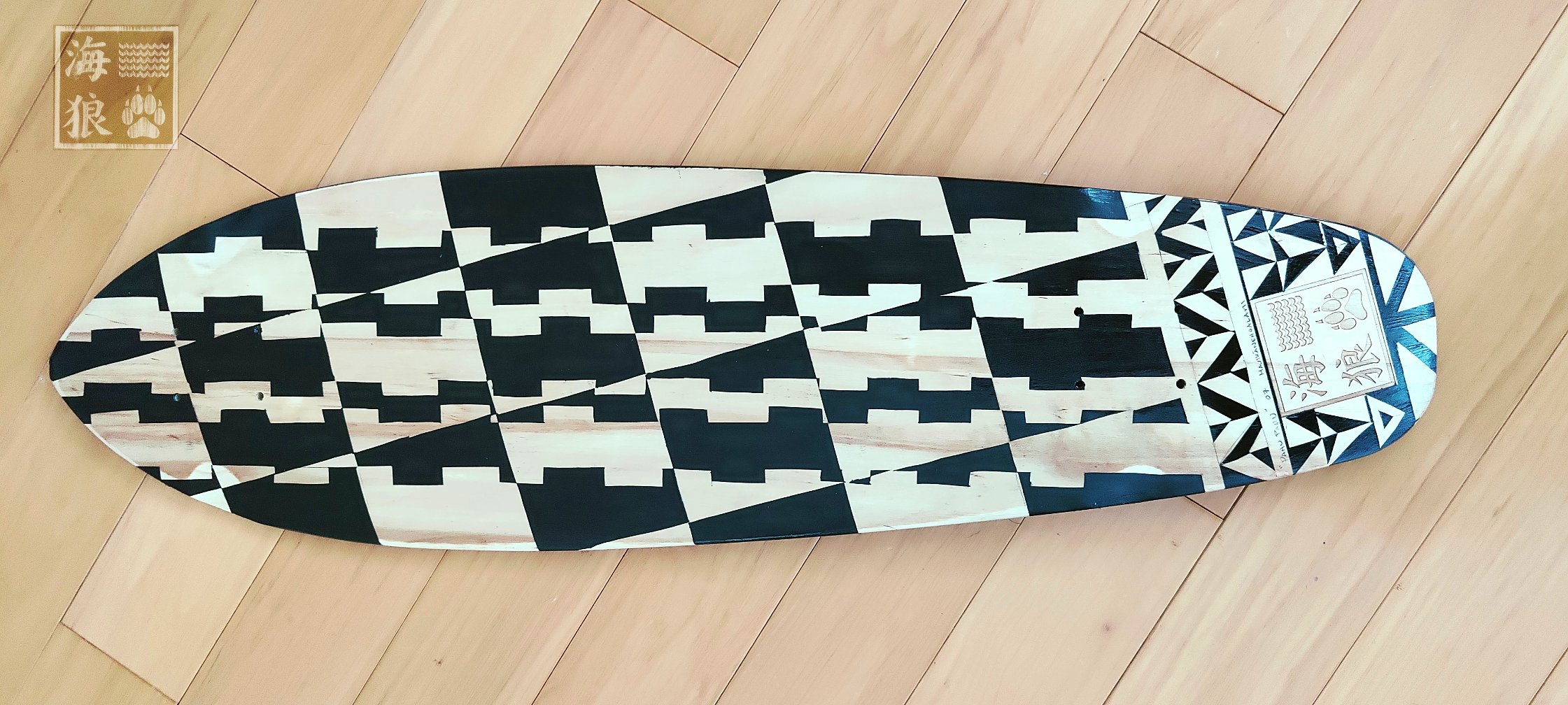 Image 2 of 6
Image 2 of 6

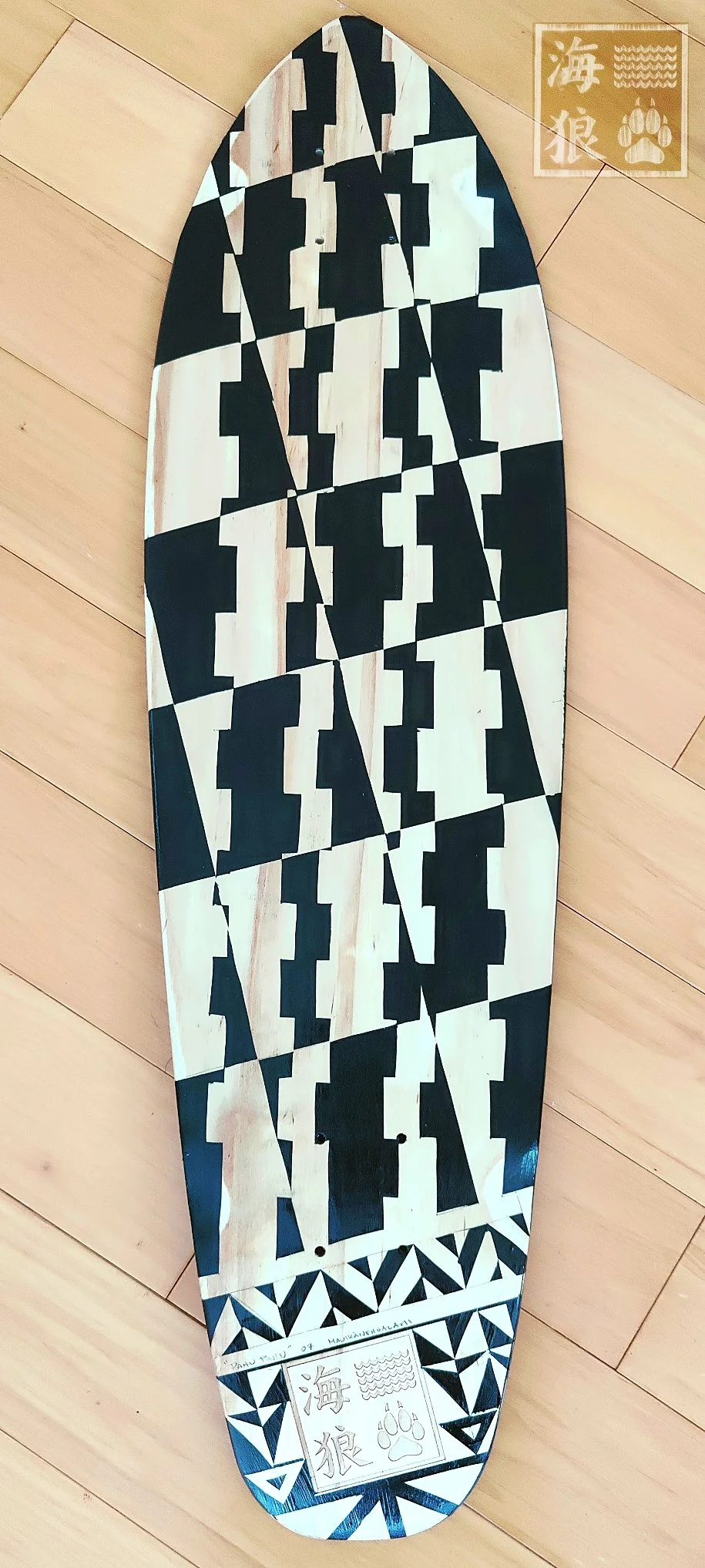 Image 3 of 6
Image 3 of 6

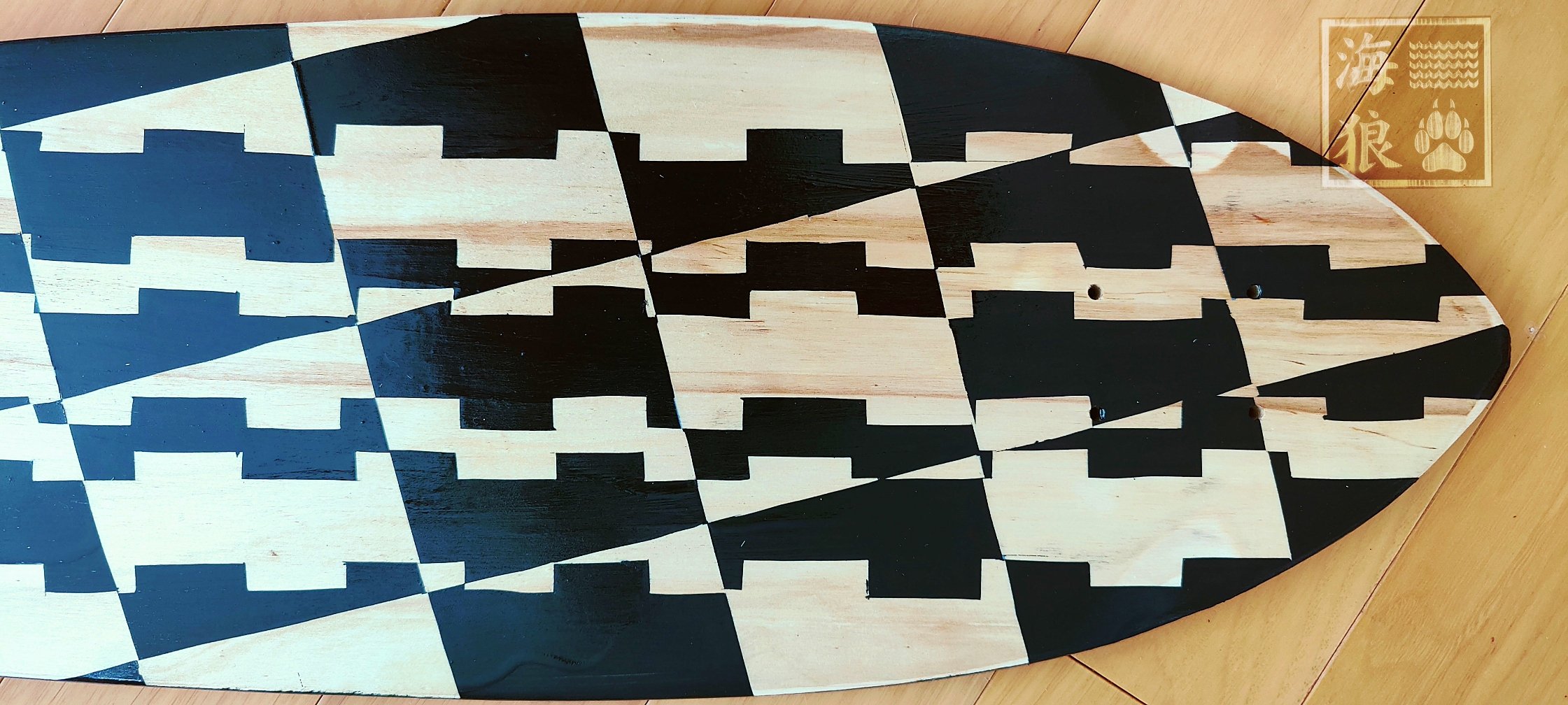 Image 4 of 6
Image 4 of 6

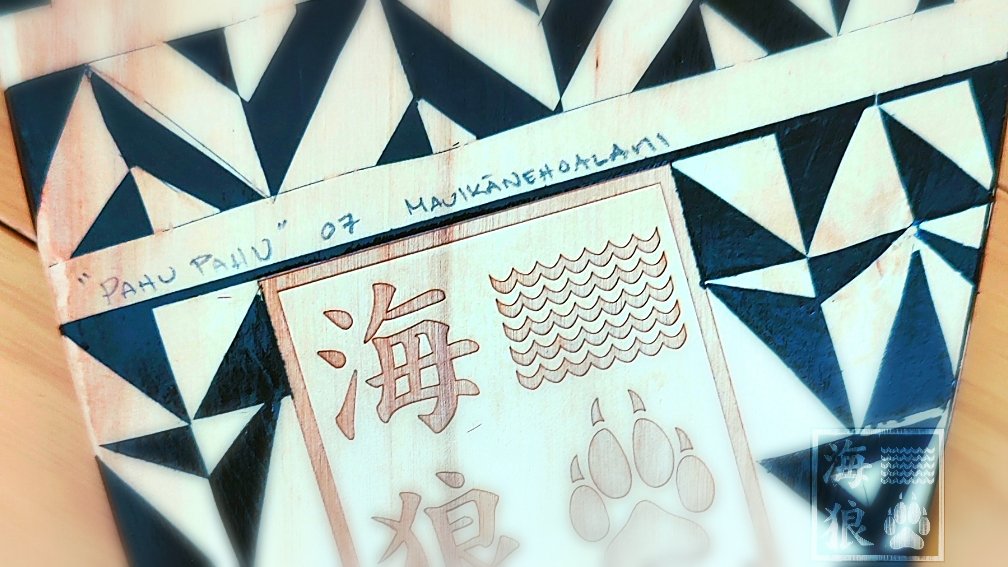 Image 5 of 6
Image 5 of 6

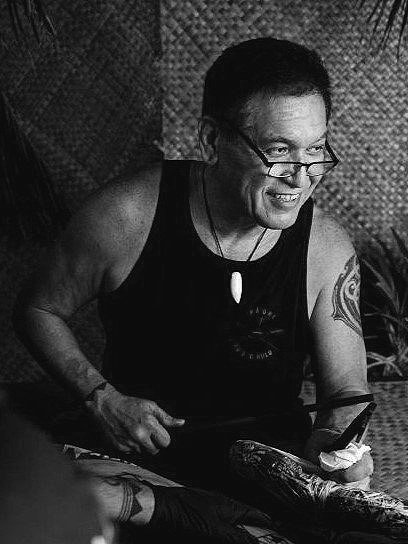 Image 6 of 6
Image 6 of 6







"PAHU PAHU" 07 PIKAPIKA X ICHIMATSU MOYOU - FINE ART SKATEBOARD DECK
Proudly designed & produced exclusively in Honolulu, Hawai’i
32” / 81.3cm overall length; 8” / 20cm width
7-ply Canadian Maple & Acrylic Ink
Includes a certificate of Authenticity, signed by KAIROU Waterman founders Mark Mauikanehoalani Lovell & Paul Kaleionamauia Okami
Native Hawaiian Made.
“Pahu Pahu” 07 draws inspiration from textiles common to feudal Japan and their patterns. The juxtaposition of Japanese patterns against Hawaiian tattoo motifs represents a style that KAIROU founder Mauikanehoalani Lovell has dubbed niokepani: nio- being a homophone of ‘neo’ (νεο-), the Greek prefix meaning “new” or “novel”; and kepani being a transliteration of the word ‘Japanese’ in the Hawaiian tongue.
Patterns used and popularized in traditional Japanese clothing are called Wagara (和柄). They originate from an era of Japan’s history known as the Heian period (occurring roughly between the 8th and 11th century). Like all works of art, each wagara composition was originally conceived to decorate. traditional utilitarian clothing like the Kimono and Yukata became an ideal canvas. Garments featuring wagara were considered more distinctive, more colorful, and more desirable - projecting status, wealth, or influence. Some unique designs were specially reserved for social elites, royal courtiers, warlords, as well as for the Shogun himself.
The pattern known as Ichimatsu, or Ichimatsu Moyou is named for famed kabuki actor Sanogawa Ichimatsu I (佐野川 市松). From 1733 until his death in 1762, at the age of forty, Ichimatsu was famed for portraying young heroes. Ichimatsu was a celebrity in every sense. During a series of performances in historic Edo (now Tokyo) during 1741, Ichimatsu wore a distinct ichidatami (checkerboard) pattern on his costuming. As the checkered pattern became a fashion trend and social craze, so too did Ichimatsu’s fame and legacy grow. Ultimately, the pattern came to be known as ichimatsu moyou, honoring the actor.
In contrast to the Ichimatsu background are three rows of pikapikaokahe’e - or octopus tentacles - reaching across the centerline of the board. A powerful symbol in the Hawaiian worldview, the octopus exists both as avatar to Kanaloa (deity of large & small waters, including the vast ocean) as well as a clever aquatic survivor, worthy of respect. The Hawaiian octopus motif is characterized by lengths of equally spaced rectangular elements, alternating from one end of a line segment to the other. Both Japanese and Hawaiian pattern sets makes for a visual feast. The look is immediately captivating and curious. A small border in the traditional Hawaiian motifs frames the KAIROU logo at the rear kick.
The board itself is a functional 32 inch long “cruiser” whose profile recalls both the traditional, finless Hawaiian wave-riding boards known as alaia, as well as the modern “hot curl” surfboards of pre-WWII era Waikīkī. This piece will add culture and style to your life, whether hanging in your home or office, skating the park, or “sidewalk surfing” around the neighborhood.
Each iteration of the “Pahu Pahu” Fine Art Series is unique and genuinely one-of-a-kind. None will ever be reproduced.
Proudly designed & produced exclusively in Honolulu, Hawai’i
32” / 81.3cm overall length; 8” / 20cm width
7-ply Canadian Maple & Acrylic Ink
Includes a certificate of Authenticity, signed by KAIROU Waterman founders Mark Mauikanehoalani Lovell & Paul Kaleionamauia Okami
Native Hawaiian Made.
“Pahu Pahu” 07 draws inspiration from textiles common to feudal Japan and their patterns. The juxtaposition of Japanese patterns against Hawaiian tattoo motifs represents a style that KAIROU founder Mauikanehoalani Lovell has dubbed niokepani: nio- being a homophone of ‘neo’ (νεο-), the Greek prefix meaning “new” or “novel”; and kepani being a transliteration of the word ‘Japanese’ in the Hawaiian tongue.
Patterns used and popularized in traditional Japanese clothing are called Wagara (和柄). They originate from an era of Japan’s history known as the Heian period (occurring roughly between the 8th and 11th century). Like all works of art, each wagara composition was originally conceived to decorate. traditional utilitarian clothing like the Kimono and Yukata became an ideal canvas. Garments featuring wagara were considered more distinctive, more colorful, and more desirable - projecting status, wealth, or influence. Some unique designs were specially reserved for social elites, royal courtiers, warlords, as well as for the Shogun himself.
The pattern known as Ichimatsu, or Ichimatsu Moyou is named for famed kabuki actor Sanogawa Ichimatsu I (佐野川 市松). From 1733 until his death in 1762, at the age of forty, Ichimatsu was famed for portraying young heroes. Ichimatsu was a celebrity in every sense. During a series of performances in historic Edo (now Tokyo) during 1741, Ichimatsu wore a distinct ichidatami (checkerboard) pattern on his costuming. As the checkered pattern became a fashion trend and social craze, so too did Ichimatsu’s fame and legacy grow. Ultimately, the pattern came to be known as ichimatsu moyou, honoring the actor.
In contrast to the Ichimatsu background are three rows of pikapikaokahe’e - or octopus tentacles - reaching across the centerline of the board. A powerful symbol in the Hawaiian worldview, the octopus exists both as avatar to Kanaloa (deity of large & small waters, including the vast ocean) as well as a clever aquatic survivor, worthy of respect. The Hawaiian octopus motif is characterized by lengths of equally spaced rectangular elements, alternating from one end of a line segment to the other. Both Japanese and Hawaiian pattern sets makes for a visual feast. The look is immediately captivating and curious. A small border in the traditional Hawaiian motifs frames the KAIROU logo at the rear kick.
The board itself is a functional 32 inch long “cruiser” whose profile recalls both the traditional, finless Hawaiian wave-riding boards known as alaia, as well as the modern “hot curl” surfboards of pre-WWII era Waikīkī. This piece will add culture and style to your life, whether hanging in your home or office, skating the park, or “sidewalk surfing” around the neighborhood.
Each iteration of the “Pahu Pahu” Fine Art Series is unique and genuinely one-of-a-kind. None will ever be reproduced.
The “Pahu Pahu” Fine Art Series honors renown Native Hawaiian tattooist Su’a Suluape Keone Nunes, his school of indigenous tattooing - Pa Uhi, and his esteemed mentor Su’a Suluape Paulo II.



